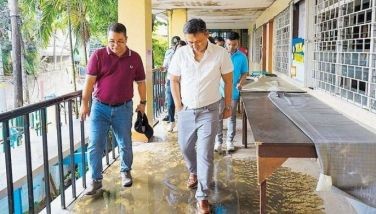Phl used Japan aid well, says envoy
ORMOC CITY, Philippines – Japanese Ambassador Toshinao Urabe is satisfied with the way Filipinos are handling the monetary assistance given to them by the Japan government for the improvement of infrastructure, educational standards and medical health service.
Urabe, however, pointed out that community cooperation is one of the main factors needed to sustain the projects and maximize their effectiveness.
“Filipino people are making good use of the money (grant from the Japan government),” said Urabe, shortly after a series of inspections of infrastructure projects here and in Tacloban since Monday.
Urabe led representatives from the Japan embassy and members of the media in visiting Ormoc and Tacloban City to check on the maintenance of the projects, including flood control programs, as part of the aid of the Japan government in 1995.
Urabe’s team inspected the Anilao and Malbasag rivers and the Biliboy split dam, all Japan-funded projects that have been proven to be effective in flood mitigation. The three projects have also served as tourist attractions in the city.
On Nov. 5, 1991, typhoon “Uring” induced tremendous amount of rainfall here, causing massive flashfloods, which killed almost 8,000 people, swept away over 14,000 houses and destroyed about P620 million in property.
With Japanese technology and grants, Ormoc City assistant district engineer Irwin Antonio said the local Department of Public Works and Highways (DPWH) constructed the Biliboy dam and widened the two rivers using models from Japan. All the projects were completed in 1998.
In 2003, Antonio said typhoon “Guilas,” which was as strong as typhoon Uring, hit the city but floodwaters were contained in the improved rivers and dam, thus proving the effectiveness of the projects.
But with the series of strong typhoons caused by climate change, Antonio said the dam and the rivers have been clogged with gravel and other deposits from the upper ground.
The DPWH official said a study showed the waterways should be desilted after every other flooding to prevent massive floods in the city.
In Tacloban City, the Japan government and the Japan International Cooperation Agency (JICA) sponsored the construction of six health centers to provide free health care, especially to pregnant women.
Arlene Santo, Tacloban municipal health officer, said the health centers have the equipment and the Japan government has been providing training for health workers and health volunteers in the town.
“An average of 50 mothers give birth at the Municipal Health Center every month. We are happy that our mothers are now aware that giving birth at home with only a hilot would be risky to their health and that of the baby,” Santo told journalists during a visit initiated by the Japan embassy.
Satoko Ishiga, chief administrator of the project “Strengthening Maternal and Child Health Service in Eastern Visayas,” said they have trained some 3,400 health workers and health volunteers who are now working to pass on their knowledge and health consciousness to the community.
- Latest
- Trending

































